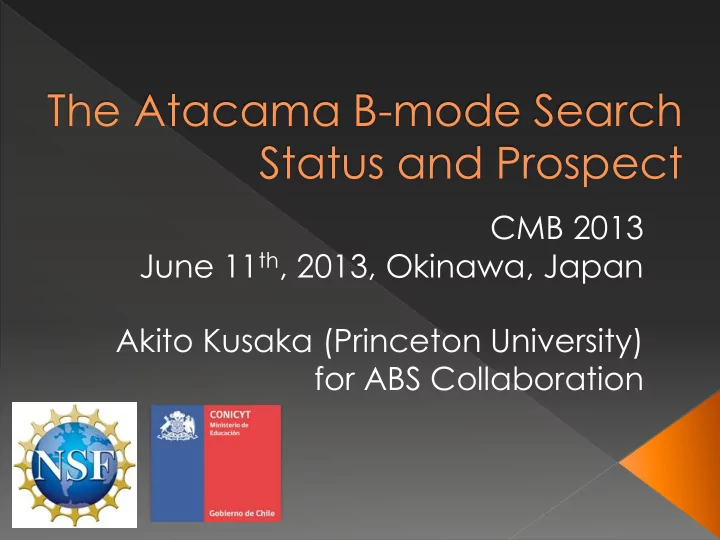

The Atacama B-mode Search Status and Prospect CMB 2013 June 11 th , 2013, Okinawa, Japan Akito Kusaka (Princeton University) for ABS Collaboration
Before starting my talk… Atmosphere is unpolarized
ABS (Atacama B-mode Search) Princeton, Johns Hopkins, NIST, UBC, U. Chile
What is ABS? Ground based CMB polarization (with T sensitivity) Angular scale: l~100(~2 ), B-mode from GW TES bolometer at 150 GHz › 240 pixel / 480 bolometers › ~80% of channels are regularly functional › NEQ ~ 30 m K s (w/ dead channels, pol. efficiency included) Unique Systematic error mitigation › Cold optics › Continuously rotating half-wave plate
Site Chile, Cerro Toco › ~5150 m. › Extremely low moisture › Year-round access › Observing throughout the year › And day and night
ACT, ABS, PolarBear, CLASS Cerro Chajnantor 5612 m (5150 m) Cerro Toco 5600 m TAO, CCAT Google Earth / Google Map 1 km QUIET, CBI APEX ALMA (5050 m) ASTE & NANTEN2 (4800 m) Possible combined analysis among CMB experiments
Many figures / pictures are from theses of ABS instrument T. Essinger-Hileman and J. W. Appel (+ K. Visnjic and L. P. Parker soon )
Optics 4 K cooled side-fed Dragone dual reflector. ~60 cm diameter mirrors. 25 cm aperture diameter.
Optics Aperture The optics maximize throughput for small aperture 12 radius field of view Good image quality across the wide field of view
ABS focal plane Focal plane ~300 mK Feedhorn coupled Polarization sensitive TES Ex TES Inline filter OMT Ey TES 1.6 mm ~30 cm 5 mm Fabricated at NIST
Focal Plane Elements Individually machined corrugated feedhorn
Focal Plane Elements Compact & modularized focal plane unit of 10 pixels (20 TES + 2 dark SQUID ch.)
Continuously rotating warm half-wave plate Demodulation Q (mK) A-cut sapphire (D=330 mm) f ~2.5 Hz rotation f ~10 Hz modulation Air-bearing Stable rotation Note: sensitivity ~ 1/ 2 No need for pair differencing
Observing and Data
Fields Observed by ABS Low foreground region selected Field B Galactic center Field A Field A: primary CMB field, ~2300 deg. 2 Field B: secondary CMB field, ~700 deg. 2
Observing cycle Calibration Azimuth (degrees) He recycle Galaxy (~7hours) Field B Field B (CMB) Field A Field A (CMB) • 48-hour fridge cycle (~7 hours for He recycle) • 41/48 = 85% observation • ~25/41 61% at CMB field A • ~11/41 27% at CMB field B • ~5/41 10% at calibration and galactic center
Calibration strategy Responsivity › Sources: Jupiter, Venus, TauA, RCW38 › Skydip › Wiregrid Polarization angle › Wiregrid, TauA Pointing, Beam: sources Detector response › Wiregrid+HWP, chopper
Wiregrid
Wiregrid Phase rotation measured by varying HWP frequency S. M. Simon (see her poster at LTD15)
HWP “constant” structure There is a “constant” HWP signal structure 2 f component dominates Small 4 f component › This is constant at the first order These can be used as calibration
HWP structure vs. pwv 2 f component 4 f component 2 f component >> 4 f component 2 f component tends to be proportional to intensity input 4 f component has less dependence on the intensity
Demodulated timestream Raw Right: TOD power spectrum Bottom: knee frequency distribution from 1 week of data Median: 1.3 mHz Demod 800 seconds ~2.5 deg. sky rotation ℓ 𝑧 ~70 Study under way: it can be better.
Impact of HWP performance Gravity wave B-mode signal ACT data (temperature) 𝐶𝐶 ℓ 𝑧 𝐷 ℓ ℓ 𝑦 Loss in low-l experiments is significant @ lowest bin Fowler et. al. (2010) 60% loss in QUIET (2012) See also Pryke et. al. (2009) 70% loss in BICEP1, Chiang et. al. (2012) ABS may gain back sizeable portion
Impact of HWP performance Extremely good rejection Number of channels of spurious polarization Most of the channels I Q/U leakage well below 0.1% › Cf. BICEP1~1%, QUIET - W~0.2% Well controlled systematic error from CMB D T and foregrounds › In “optimistic” dust model, dust D T+leakage may be dominant I Q/U leakage (%)
Summary ABS › 480 TES + unique systematic mitigation › In particular, warm continuously rotating HWP opens a very interesting phase space in experimental configuration Status › Observing!!
Recommend
More recommend